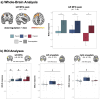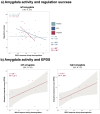Neural emotion regulation during pregnancy: An fMRI study investigating a transdiagnostic mental health factor in healthy first-time pregnant women
- PMID: 40800908
- PMCID: PMC12319865
- DOI: 10.1162/imag_a_00529
Neural emotion regulation during pregnancy: An fMRI study investigating a transdiagnostic mental health factor in healthy first-time pregnant women
Abstract
Pregnancy is a psycho-neuro-endocrinological transition phase presenting a window of vulnerability for mental health. Emotion regulation, a transdiagnostic factor for psychopathology, is influenced by estradiol across the menstrual cycle on the behavioral and neural level. Whether this is also the case in the antepartum period remains unknown. For the first time, behavioral and neural emotion regulation were investigated in healthy pregnant females with extremely high estradiol levels during the second trimester (N= 15) using a functional magnetic resonance imaging (fMRI) paradigm. Results were compared with naturally cycling females with high (N= 16) and low estradiol levels (N= 16). Although pregnant females reported the lowest trait use of cognitive reappraisal, all participants successfully regulated their emotions by applying cognitive reappraisal in the scanner. During downregulation of negative emotions, all females had increased activity in the left middle frontal gyrus. Pregnant females showed no significant differences in functional connectivity (psychophysiological interaction, resting-state) related to emotion regulation compared with the nonpregnant groups. However, group differences emerged for amygdala activation. In pregnant females, increased amygdala activity predicted reduced regulation success and was positively associated with depression scores. This first fMRI study during pregnancy indicates that depression scores are reflected in heightened amygdala activity already observable in the antepartum period. Thus, through its association with reduced regulation success, increased amygdala activity suggests a neural risk marker for peripartum mental health. The findings highlight the importance of investigating neural and behavioral emotion regulation in the ante- and postpartum period, eventually allowing enhanced identification, prevention, and treatment of peripartum mental ill-health.
Keywords: emotion regulation; fMRI; functional neuroimaging; peripartum mental health; pregnancy.
© 2025 The Authors. Published under a Creative Commons Attribution 4.0 International (CC BY 4.0) license.
Conflict of interest statement
The authors declare no competing interests.
Figures




References
-
- Abler , B. , & Kessler , H. ( 2009. ). Emotion Regulation Questionnaire—Eine deutschsprachige Fassung des ERQ von Gross und John . Diagnostica , 55 ( 3 ), 144 – 152 . 10.1026/0012-1924.55.3.144 - DOI
-
- Ammari , R. , Monaca , F. , Cao , M. , Nassar , E. , Wai , P. , Del Grosso , N. A. , Lee , M. , Borak , N. , Schneider-Luftman , D. , & Kohl , J. ( 2023. ). Hormone-mediated neural remodeling orchestrates parenting onset during pregnancy . Science , 382 ( 6666 ), 76 – 81 . 10.1126/science.adi0576 - DOI - PMC - PubMed
-
- Bach , M. , Bach , D. , de Zwaan , M. , & Serim , M. ( 1996. ). Validierung der deutschen Version der 20-Item Toronto-Alexithymie-Skala bei Normalpersonen und psychiatrischen Patienten [Validation of the German version of the 20-item Toronto Alexithymia Scale in normal adults and psychiatric inpatients] . PPmP: Psychotherapie Psychosomatik Medizinische Psychologie , 46 ( 1 ), 23 – 28 . - PubMed
LinkOut - more resources
Full Text Sources
